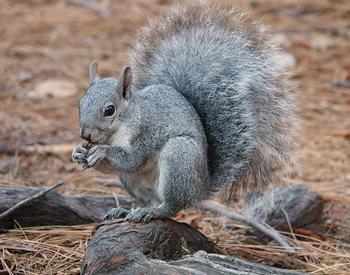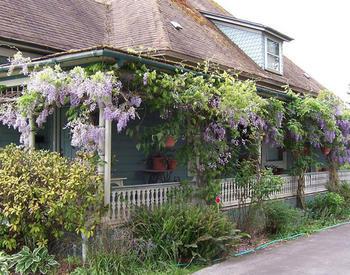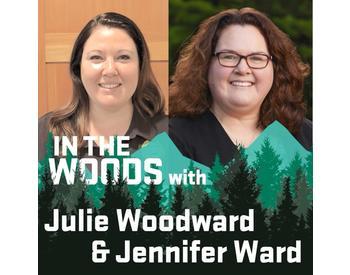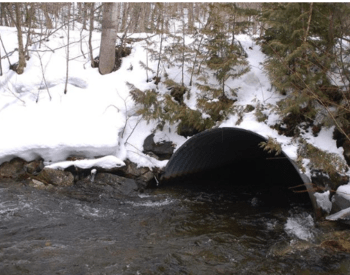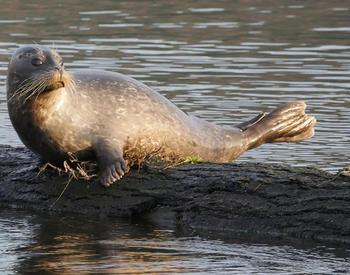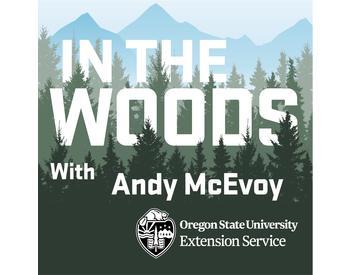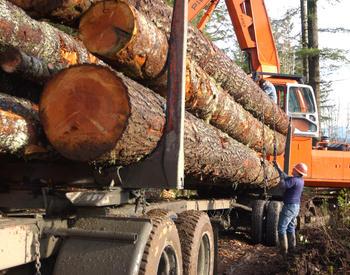Transcript
From the Oregon State University's Extension Service you are listening to In the Woods with the forestry and natural resources program. This podcast aims to show the voices of researchers, land managers, and members of the public interested in telling the story of how woodlands provide more than just trees. They provide interconnectedness that is essential to your daily life. Stick around to discover a new topic related to forests on each episode. Welcome to this segment of the In the Woods podcast. My name is Steve Fitzgerald I'm the extension silviculture specialist and I'll be your host today. So, in this segment we're gonna we're talking about reforestation and I'm out in the forest today and it's cloudy and misty in western Oregon and I'm here with Carli Morgan. Carli, why don't you tell me your title and where we are and and a little bit about what we're doing out here on this site. Yeah, great, I'm Carli Morgan, and I manage the reforestation, forest inventory, and GIS programs for the OSU research forests. Today, we're out on the McDonald-Dunn Forest planting it's the beginning of February here. We're actually on our last day, we've been planting all through January. This unit we call Bermuda triangle, it's about 14 acres. We did plant it last year, but it had some mortality so we're doing inter-planting with some trees that I had left over for the season. So, that's interesting Carli that on out here you're interplanting, so you had planted this the year before but not all the planted seedlings make it I often thought that if you planted the ceiling you know it was good to go. Uh not always it depends on a lot of factors you know vegetation management, the soil productivity, the weather that occurs that year. There's a lot of factors with quality from our nurseries as well so you never quite know exactly the cause of mortality and sometimes you end up with some unexpected events. So, with the mortality couldn't you just walk away and say good good enough or is there a reason a particular reason why you're interplanting this? Um so we interplanted this or sorry we planted this the first time last year and we saw much higher mortality than we're okay with uh greater than 50 percent. Wow, that's that's that's a lot. It's a lot uh if you'll remember 2021 we had we experienced some record heat events in Oregon. I remember that that was the heat dome event. Yes, and we think that contributed to some of the mortality the higher than usual mortality that we're seeing in some of our young plantations. These trees were you know fresh from the nursery and uh from what I recall we February and March were also pretty dry months last year so the drought really affected us. So, Carli, um you were out on this area and this was a harvest unit um you know why why plant trees? Well uh you know forests are a sustain or reusable sustainable resource so we see it as our responsibility to future generations and to the work that we do here on the research forest we manage forests for a variety of reasons and so us reforesting a site gives us more options for future management decisions. We're also required under state law to reforest sites. So, the Oregon Forest Practices Act applies to this site. We need to get 200 trees per acre growing here within the next six years post harvest. So, we are expected to meet those legal requirements unless we apply for a waiver to do something else and that is approved by the Oregon Department of Forestry. So, we talk about you know a big deal these days is managing forests sustainably, so you know here we harvested some trees and it seems like replanting is really a basic tenet of uh for sustainability. Yeah, definitely, um you know we we plant more than that 200 trees per acre because we expect some mortality. Where we can and we're the site's favorite we do a mix of species. Douglas fir is definitely still our number one species that we plant but you know when we have sites with some nice shady or some wetter areas we'll do Western Red Cedar. On this site we did some Incense cedar up high in really sunny spots. We're experimenting more with that species in inland dry sites like the McDonald-Dunn Forest could be really great spot in the future for these trees. We also planted Ponderosa pine this year so every year it's a mix of species and we're trying to integrate more diversity into the reforestation program. Well Carli you know last last year's heat dome event got me thinking and there's courses a lot of a lot of discussion about climate change and its impact on forests. So, you know what impact would it have like on these baby trees that you're planting uh particularly going into the future? Um well last year was a great example of something that we could face more frequently. Extreme heat events extended periods of drought, so we're anticipating these changes and we're trying to plant trees that can survive now, but also thrive in the future. And so that's why we're looking at a suite of factors when we're planting trees um it's a definitely a long-term mindset. Yeah, indeed, and you know it a lot of it depends on how high temperatures get and how fast do these temperatures climb and you know there's a lot of talk about assisted migration you talked here really about planting some other species and some of those like Incense cedar and Ponderosa pine tend to be a bit more drought tolerant. Yeah, definitely we're also expanding our view of seed sources for Douglas fir especially you know it used to be that you could have pretty reliable results if you planted trees within a certain seed range you could you know expect certain survival, certain growth, but climate change has the potential to really alter those things as well. So, we use sources like the seed lot selection tool developed by OSU. Some great researchers out of OSU. Just to experiment and look at you know potential future impacts and where should we be getting seed and so we do the some of the seed we're experimenting with for Douglas fir is down near Roseburg, low elevation, it's definitely a warmer drier climate down there and perhaps some of that seed is going to be better suitable here in the future, those trees. And we're we're looking for sourcing additional seed that's perhaps more adapted for future environments or future climates I should say. So, Carli let's go take a look at the planting and the planting crew and take a walk through this this unit. Okay, sounds good.
So, the planting planting crew has come back to the truck to pick up some other seedlings. And the seedlings go into bags that are strapped around their waist. And uh they'll put about 50 or so seedlings in their or more of seedlings in their bag and take them out to the unit where where they'll plant them.
And off to the races they go to continue planting.
So, the planting crew is scraping some of the vegetation and and slash away so that they can create a a plantable hole to put the seedling in. This is very hard arduous work and um they do it with a smile on their face and it's just amazing to watch them work and how fast they could plant all these seedlings. We're planting several thousand out here today all by hand. In fact, they're planting so fast I'm having a hard time keeping up with them that's I know that I planted trees and I am way slower than what these professional tree planters can do. I'm also out here with Ruth uh Ruth can you tell me your full name uh, what you're doing out here, um and I and I believe you are a student in the college of forestry. Yeah, that's correct so my name is Ruth McCullough. I'm out here taking plots of after these guys are planting everything and I'm a student of natural resources in the college of forestry. Great, so you're so you're taking plots so you're following this planting crew so tell me what you're looking at in the plots. So, what I'm looking at is to make sure the trees are spaced out at about 10 to 11 feet apiece and also if they're buried correctly so making sure all the roots are below ground and they're not leaning to the side so just making sure they're done correct. So, how is this crew doing so far? So far so good everything's looking good for the most part no major problems they're all spaced out pretty well. So, you have a tape measure to measure your plot. How big is your plot? So, the radius is about 13.8 feet and that just makes sure that each plant each tree is separated by about 10 to 11 feet. So, then how many seedlings do you need to have in your plot roughly? Uh, we're looking for six. Six, and that would more or less give you what what you need for spacing. Correct, yeah. Okay, so I see we have a seedling down here so is this one in or is it out? So this one looks like it's in. Okay. So we count that as one and we just walk in a circle counting all the trees that are within this 13.8 foot radius and looking for six. Okay, so Ruth you just completed going around with your plot, so how many how many seedlings did you get? So, this plot actually ended up having eight trees. Eight trees, so a little bit more than what a little bit more. But that's okay because we have extra trees, and we need to get this is our last day of planting we need to get them all planted so it kind of... Yeah. It just happens. I noticed in this plot or there's a lot of slash and so for those that don't know what slash is it's the branches and tops of trees that remain after the trees have been harvested. Is this a problem for the trees? Or a problem for the tree planters? It does take away some plantable area so we do have to keep that in mind that sometimes we just can't plant as many because there is slash we can't really plant in the slash. Okay, well thanks for that that's that's great. So, Carli we have a planted seeding here. Can you kind of describe what this seedling looks like and what you are looking for in a healthy seedling? Sure uh so we're planting plugs today... Meaning? What's what's a plug? So, a plug is grown in a container cell and they come in various sizes. It's really nice because you can grow them in just one year at the nursery and then they're ready for out planting. So it's a it's a nice uh seedling to add to your mix. So, when you say cell that's the cell that it's actually the medium that it's growing in? Yep, they're grown usually in styrofoam blocks and then the cell is that space inside the block. The seedlings that we ordered are a 615 and that refers the six refers to the diameter of that cell at the top and 15 centimeters long okay um they come in very so you order them essentially by the amount of growing room in that little cell in the container. Gotcha gotcha. But yeah this seedling here is over 12 inches tall it's probably closer to 15 or so it has a really vivid bright green color which is an indicator of at least when it was pulled from the cell in still good growing conditions we're we're not seeing off color like a lot of yellowing or a lot of red needles. Um we can see buds on this tree a good number of buds I can see the buds yes and that's a nice sign that this tree's gonna put on some leaves this coming year in the right growing conditions. These buds will break in about May and start putting on new leaf growth. Under the ground the the plug has a root a little root system it's probably well it should be about 15 centimeters long because of our cell size but it's nice because those roots are still contained with soil. It's very it's easier for our planters to plant than a bare root plug which has no soil on the roots um these are just very they might be a little heavier than bare root but the planting underground like we usually don't even have to check the roots because these are just easy planting on the right site. Gotcha, okay, well that's uh this seedling does look great um you know the ceiling's out here is there anything that we talked about temperature, but is there anything else that can affect the survival of the seedling? So we we talked a little bit about soil, so this site actually has some of our best soil. We talked about weather conditions and these trees are also going to face some competition from you know vegetation that comes up this year and then there's also wildlife out here that are going to possibly browse these trees. Like what? Uh deer, elk are our biggest uh kind of our biggest herbivores that come out and snack on our trees. So, despite having this beautiful and healthy seedling it still has some obstacles to face before it eventually is established and grows into a mature tree. Yesterday we actually at one of our sites with really bad deer and elk brows even on Bare Root trees which can be a bit larger than these plugs we had to tube all of the trees the Western Red Cedar and the Douglas fir because we're just seeing such extreme browse on that site. So, you mentioned tubing trees to protect them from deer and elk, can you describe what what tubing is? Yeah, so uh tubes are they're called Vexar tubes they're designed to slowly degrade over time uh which is a nice feature of the tube. They they look kind of plasticky I don't know the exact the exact material, but it does break down over time. So, the from the light? Is that what breaks it down? Yeah, the light and the heat out here um which is nice so we're not leaving a lot of you know other man-made materials on site and then we use bamboo stakes to weave inside that tube and then we place it over the seedling. And that tube you know has it lets through lots of air lots of sunlight but it helps prevent those deer and elk from getting directly to the seedling so at least for a few years. So, the tube is more like a mesh tube rather than a solid tube? Yes, uh-huh mesh. And how long does it take before you see the tube begin to break down from the heat and the light? You know I think it starts happening in the first five years they start becoming brittle and breaking apart, so ideally that tree is able to grow up and start getting above browse height uh before you know coming out of that tube. Yeah, is uh how expensive is that to tube these trees? Um it's pretty expensive you know because there's a materials cost for the bamboo and the tubes and then we have to it takes a person to tube each tree individually so that's another labor cost there yeah in addition to the planting. So, Carli there's a lot of pieces to it seems like to reforestation and getting trees in the ground and you know getting them to grow, but I'm thinking back even before they're even planted in the ground thinking about "Well you have to grow them." So what what kind of planning does that take in getting these seedlings grown you said at a nursery. Yep, so that piece can be a little difficult because you're trying to predict which sites are going to be ready for planting and you're placing orders for trees for plugs about a year and a half before you're planting and for Bare Root trees that can be two and a half years ahead of planting the site wow so a lot of you know harvesting schedules whatnot, things can change. So, I try to order a mix of things um a mix of trees to work with you know we have a site up north so I use a lot of coastal Douglas fir up there or Douglas fir that's more adapted to wetter climates. Down here, we use a couple different types of Douglas fir, a bare root, and plug and we use of course some of these other species, but yeah so you need to place those orders with nurseries they grow our seed and again we try to diversify there because nurseries can have their own troubles too. Sometimes lifting the bare root trees out of the ground is difficult, so when you're working with multiple nurseries you can kind of hedge your bets there too that your trees will be available and they'll be successful and nice. And then for the seed we're part of a cooperative at the J.E. Schroeder nursery which is operated by the Oregon Department of Forestry and there's a group of landowners uh because we can't afford to employ our own you know geneticists right staff and run an orchard we just we don't have the land base for that. So, we work with other landowners to have seed sourced forests. And so this seed came from sites throughout Oregon from trees that had desirable traits it was collected out there from native trees and then it was bred and grown out in an orchard and then you can continue to select trees that have desirable traits whatever that be wood strength, maybe some insect or disease resistance, maybe in the future it'll be more like resistance to extreme drought or something. So, you can select desirable parent trees and breed them and grow them out for future planting seed. Wow, that's there's there's quite a bit to that part. Yeah, there's a lot of specialists involved in this whole reforestation chain. So, Carli um I want to kind of bring the podcast to an end, but you know you're planting the trees but you just don't walk away from this. What else do you have to do following the planting? Yeah, that's a really really good point. So, we're planting here today I like to monitor these new sites pretty heavily through the first through that first year especially when you're talking about extreme heat and drought um... And probably deer and elk. And deer and elk and all these things so we kind of do a walk through informal visual survey that first year. The students and I will go out to the sites, we'll walk it, we're looking you know are these trees turning red? Are they dying right away in that first year they're really visible? And that can help us catch issues and correct them early on, but uh we continue monitoring these sites at year three at year five uh we do some official stocking surveys. We'll design an inventory and put plots out here. So, kind of like what Ruth was doing earlier today? Yeah, but even more detailed we'll measure trees we'll look at the height growth we'll look at some of the competition or you know browse factors, what are what's their vigor, essentially? So, we will at a point actually start taking data on these trees, and that helps me determine are we meeting the number of trees we want for that site? And are they quality trees going forward? Okay, Carli before we wrap this podcast up let's get into the lightning round of questions.
What is your favorite tree?
Let's see, I really like Western Hemlock. When it's mature you find it growing on some really nice sites typically wet, cool areas with rich soil. It tolerates shady conditions and Western Hemlock loves sprouting from old decaying logs, we call those nurse logs. What is something unique that you carry in your cruiser vest that helps you with your work? For this reforestation work you'll definitely want a distance tape. I carry a handy tape that has diameter on one side for measuring trees and distance on the other side which helps with these fixed radius plots. The next most useful thing I carry is a chart for reading measurements on a relascope, which is a pretty complex little tool, but very helpful and probably best explained on another podcast.
What other resources can you share on reforestation for a listener that would like to dive deeper on the subject? Your local OSU extension office and forestry agents are great resources. They have a website with some further reading on reforestation and forestry topics. Also, there's a free Guide to Reforestation in Oregon document written by Robin Rose and Diane Haase. And finally there's some cutting edge research coming out of the VMRC or Vegetation Management Research Co-op, and that lab is led by Carlos Gonzalez-Benecke and Max Wightman. Well Carli, uh thanks for for all this has been this has been great. I see the planting crew is way out ahead of you, so I know you have to go catch up with them. So, anyway thank you so much for being on this podcast. Yeah, thanks Steve it was a great time having you out here. Okay, take care, bye.
Thank you so much for listening. Show notes with links mentioned on each episode are available on our website inthewoodspodcast.com. We would love to hear from you, visit the tell us what you think tab on our website to leave us a comment, suggest a guest or topic, or ask a question that can be featured in a future episode. And also, give us your feedback by filling out our survey. In the Woods was created by Lauren Grand, Jacob Putney, Carrie Berger, Jason O'Brien and Stephen Fitzgerald who are all members of the Oregon State University Forestry and Natural Resources Extension Team. Episodes are edited and produced by Kellan Soriano. Music for In the Woods was composed by Jeffrey Hino and graphic design was created by Christina Friehauf. We hope you enjoyed the episode and we can't wait to talk to you again next month. Until then, what's in your woods?
In this episode, Stephen Fitzgerald discusses reforestation with Carli Morgan at the McDonald-Dunn Forest planting site. Morgan manages the reforestation, forest inventory, and GIS programs for the OSU research forests.



